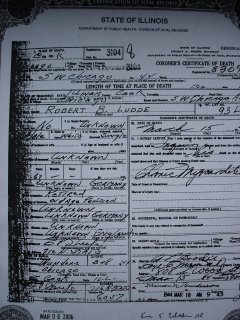For many decades, the fate of Robert Bernhard Ludde remained a mystery. The last postcards he sent to his family were kept, but he was never hear of again. As I mentioned in my other blog about
Mary Burnard (his mum) , his last visit to Germany 1938 convinced him that he never wished to return.
Rather than explore his fate step by step, in the age of the internet it took one day to clear up the mystery. He was born in 1877, went to live in Milwaukee, Wisconsin in around 1908, appears in the 1910 Federal Census, lived in Cook County, Illinois at the time of Draft Registration for WWI, later lived in downtown Chicago during the 20, 30s and early 40s. His last known address was 5, West Chicago Avenue, which
still exists today, occupied by Walsh Construction. He died on March 15th, 1944 in Cook County (Cert. No 0008309) and is buried at Wunders cemetery in Chicago. ...
End of Story ? No way, it merely means we must go into much greater detail. The first part of our investigation will trace his arrival in the USA - how did he get there, when did he become a citizen of the USA, where did he live etc. Trust him to pick the "Beer Capital" of the USA as starting point, along with many fellow Germans. The second part will trace his railroad career. If I am right that he worked for
Chicago & North Western Railroad between 1920 & 1936, then there must be traces. The accounts say he had a senior position ... so it should be even easier. The third part will compare entries in the Federal Census records between 1910,20,30 and 40 - the last one he would have participated in. The amount of detail recorded was amazing. He must have done well to give away money to his nephews and nieces in 1938 - but what was the story by 1940? The fourth and final part will trace his death. Did he have a family and children? Was he ill, dying at the age of 67 ? Was there an obituary in the newspapers? Did he die poor and if not, what happened to his assets ?
As you can see - there will be plenty to explore once I get around to it. And - at least one more Photo picturing him outside his house in Chicago. However, this might take years, not days to complete. Enjoy!
 The two images below picture him sitting in his garden and in front of his house sometime between 1910 and 1915.
The two images below picture him sitting in his garden and in front of his house sometime between 1910 and 1915.
 He seems quite chuffed and keen to show his relatives how well he is doing in America. Strange that did not take pictures after that ... after all, the family legend says he did well for himself.
He seems quite chuffed and keen to show his relatives how well he is doing in America. Strange that did not take pictures after that ... after all, the family legend says he did well for himself.
 The two images below picture him sitting in his garden and in front of his house sometime between 1910 and 1915.
The two images below picture him sitting in his garden and in front of his house sometime between 1910 and 1915.
 He seems quite chuffed and keen to show his relatives how well he is doing in America. Strange that did not take pictures after that ... after all, the family legend says he did well for himself.
He seems quite chuffed and keen to show his relatives how well he is doing in America. Strange that did not take pictures after that ... after all, the family legend says he did well for himself.






